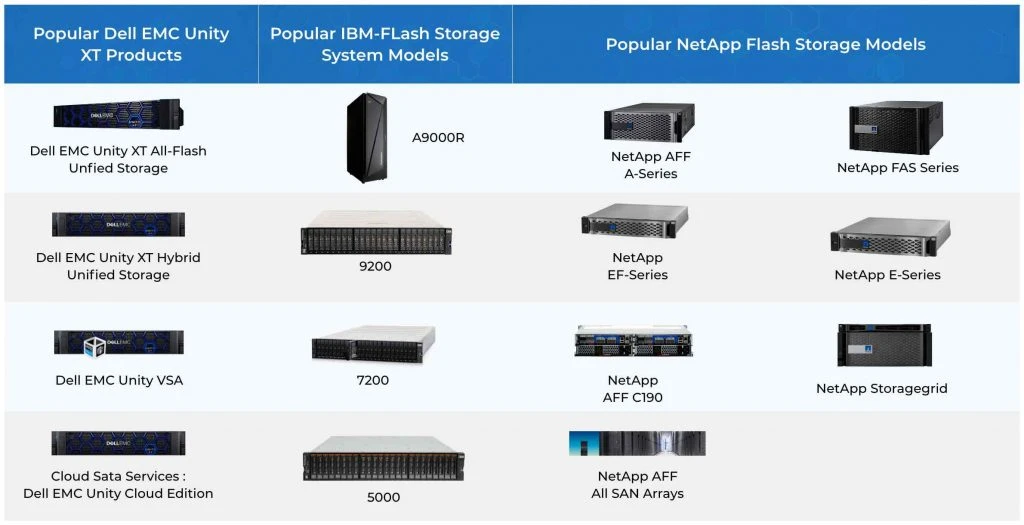Dell EMC Unity XT Vs IBM All-Flash System Vs NetApp Flash – Which one should you opt for supporting your critical virtual applications and workloads in hybrid cloud environments? Let’s find out which of these unified storage solutions will serve your purpose.
IBM All-Flash System Overview
Backed by IBM’s data management leadership, IBM Flash Storage is a trusted name for keeping your data secure and accessible. With a set of unified software and APIs, IBM Flash System simplifies the diverse storage needs in hybrid multi-cloud systems. Plus, you get on-demand IBM cloud experience based on your storage demand.
IBM All-Flash System: Highlighting Features
- Manage big data workloads
- Converged infrastructure for network, storage & compute requirements
- Enjoy the next-gen data protection & resiliency
- Combining the performance of NVMe with the innovation of IBM FlashCore & IBM Spectrum Virtualize
- Ultra-low latency and mission-critical reliability
- Storage virtualization & virtual disk mirroring
- IBM Cloud Private along with public cloud offerings
- Virtual desktop infrastructure
- Real-time analytics
- Accelerated performance with data reduction
Dell EMC Unity Storage Overview
Dell EMC Unity XT Flash arrays transform traditional storage infrastructure with optimized speed, efficiency and hybrid cloud environments. Resource-constrained SMBs and enterprises can opt for Dell EMC All-Flash and Hybrid-Flash storage systems to support their virtualized applications and achieve the unified storage for their remote or multi-branch offices.
Dell EMC Unity XT Features to Consider
- NVMe ready architecture ensures faster data access
- Optimized data capacity with 5:1 data reduction
- Flexible cloud consumption options
- Higher flexibility to support operational demands
- Connectivity for NAS and iSCSI
- Inline data reduction
- Native data protection
- Extended file system
- Dual active infrastructure
NetApp’s Flash Storage System Overview
Providing a high-speed data storage technology, NetApp flash storage system, can help organizations that are having issues with running huge data volumes, and slow and unpredictable data access. As one of the best solutions for flash cloud storage NetApp can help organizations in the following manner:
Accelerated application performance: Clients can use NetApp’s flash storage solution services to accelerate applications function of an organization.
Improved results with data center: Organizations can use its hi-end flash technologies infrastructure for further increase the applications’ performance.
Future-Ready Business processes: Integrating flash in your datacenter is critical as it helps you choose a flash system that supports changing business needs. All-flash systems that offer non-disruptive scale out make it possible to start small and grow big.
NetApp’s Flash Storage System: Highlighting Features
- It promises a 40 percent growth in application speed and efficiency
- You get cloud data services and enterprise storage capabilities on public cloud
- It provides a relentless access to the data useful for your business
- Ensure a total security of your data with end-to-end encryption, no matter where it is stored.
- Use it to scale-up your business. Also you can leverage IT as a growth engine for your business.
- Amplify cost-saving efficiency and power private clouds to scale up business
- You get rich data services and agile cloud connection that will help in growth
- Large-scale single namespace management with local and remote caching

Demographic Factors
- Based on Company Size
Mid-sized companies & large enterprises with the company size ranging from 50M to 1B and higher are the biggest adopters of IBM All-Flash storage systems.
Small businesses with the turnover of less than 50 M USD constitute as the major users of Dell EMC Unity XT products.
Companies that are mid-sized or large enterprises with approximately a net worth of $50million to $1Bn are the adopters of NetApp flash storage system.
- Industry Wise
IBM All-Flash System is popularly in demand across industries like Services, Energy & Utilities.
Manufacturing, finance and healthcare sectors prefer Dell EMC Unity Storage systems over others.
Banking, finance sector, and insurance (BFSI), manufacturing, healthcare, and media managing are some of the industry clients that NetApp has.
IBM Flash System Vs Dell EMC Unity Vs NetApp Flash Storage System: Who Stands Out as Winner

Some of the most preferred functions of Dell EMC Unity XT are flexible deployment options, dual active architecture and VMware integration. Also, it can be used across multiple web browsers and operating systems for optimized storage performance.
However, if you are planning to maximize your storage performance while your budget is flat, IBM Flash can be a better option. It supports large critical workloads while using your existing applications. IBM Flash systems’ super speed is combined with the NVMe technology to ensure deeper data insights. It further enhances your storage efficiency with the use of technologies for deduplication, compression and pattern removal.
Especially if you have switched to or planning to take up virtual data infrastructure (VDI), IBM Flash storage can ensure higher performance standards with proper handling of sudden spikes in data traffic. Are you looking for a more detailed comparison between IBM All-Flash System and Dell EMC Storage? Click here
Like Dell EMC Unity XT, NetApp’s flash storage system is easy to deploy, flexible and help you scale up your business with both on-premise and cloud deployment. It simplifies the most of your complicated tasks. And most importantly, it helps you reduce your spending on cloud almost close to half, which in-turn help you save your unnecessary spending on cloud.
Kalpana’s tech writing journey began in 2017 with Techjockey, and she truly belongs here! If she was not a technical content writer, she would have been a coder. Technical writing, especially for business software, is her passion, and she enjoys every bit of it. From addressing the pain... Read more






























